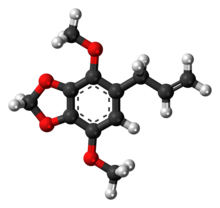
| |

| |
| Names | |
|---|---|
| Preferred IUPAC name
4,7-Dimethoxy-5-(prop-2-en-1-yl)-2H-1,3-benzodioxole | |
| Other names
5-Allyl-4,7-dimethoxybenzo[d][1,3]dioxole
1-Allyl-2,5-dimethoxy-3,4-methylenedioxybenzene | |
| Identifiers | |
3D model (JSmol)
|
|
| ChEBI | |
| ChEMBL | |
| ChemSpider | |
| ECHA InfoCard | 100.007.592 |
| EC Number |
|
| KEGG | |
PubChem CID
|
|
| UNII | |
CompTox Dashboard (EPA)
|
|
| |
| |
| Properties | |
| C12H14O4 | |
| Molar mass | 222.23 g/mol |
| Density | 1.151 g/mL |
| Melting point | 30 °C (86 °F; 303 K) |
| Boiling point | 294 °C (561 °F; 567 K) |
Except where otherwise noted, data are given for materials in their standard state (at 25 °C [77 °F], 100 kPa).
| |
Apiole is a phenylpropene, also known as apiol, parsley apiol, or parsley camphor. Its chemical name is 1-allyl-2,5-dimethoxy-3,4-methylenedioxybenzene. It is found in the essential oils of celery leaf and all parts of parsley.[1] Heinrich Christoph Link, an apothecary in Leipzig, discovered the substance in 1715 as greenish crystals reduced by steam from oil of parsley.[2] In 1855 Joret and Homolle discovered that apiol was an effective treatment of amenorrea or lack of menstruation.
In medicine it has been used, as essential oil or in purified form, for the treatment of menstrual disorders and as an abortifacient. It is an irritant and, in high doses, it can cause liver and kidney damage.[3] Cases of death due to attempted abortion using apiole have been reported.[4][5]
Hippocrates wrote about parsley as an herb to cause an abortion.[6] Plants containing apiole were used by women in the Middle Ages to terminate pregnancies. Now that safer methods of abortion are available, apiol is almost forgotten.
- ^ Azeez, Shamina; Krishnamurthy, K. (2008). Chemistry of Spices. Calicut, Kerala, India: Biddles Ltd. pp. 380 & 404. ISBN 9781845934057.
- ^ Shorter, Edward (1991). Women's Bodies: A Social History of Women's Encounter With Health, Ill-Health, and Medicine. New Brunswick, NJ: Transaction Publishers.[page needed]
- ^ Amerio, A; De Benedictis, G; Leondeff, J; Mastrangelo, F; Coratelli, P (January 1968). "La nefropatia da apiolo" [Nephropathy due to apiol]. Minerva Nefrologica (in Italian). 15 (1): 49–70. OCLC 100396864. PMID 5736450.
- ^ Quinn, Louis J.; Harris, Cecil; Joron, Guy E. (15 April 1958). "Apiol Poisoning". Canadian Medical Association Journal. 78 (8): 635–636. PMC 1829842. PMID 20325694.
- ^ Hermann, Kate; Le Roux, Anne; Fiddes, F.S. (June 1956). "Death from apiol used as abortifacient". The Lancet. 267 (6929): 937–939. doi:10.1016/s0140-6736(56)91522-7. PMID 13320936.
- ^ Sage-Femme Collective (2008). Natural Liberty: Rediscovering Self-induced Abortion Methods. Natural Liberty. ISBN 978-0-9645920-0-1.[page needed]